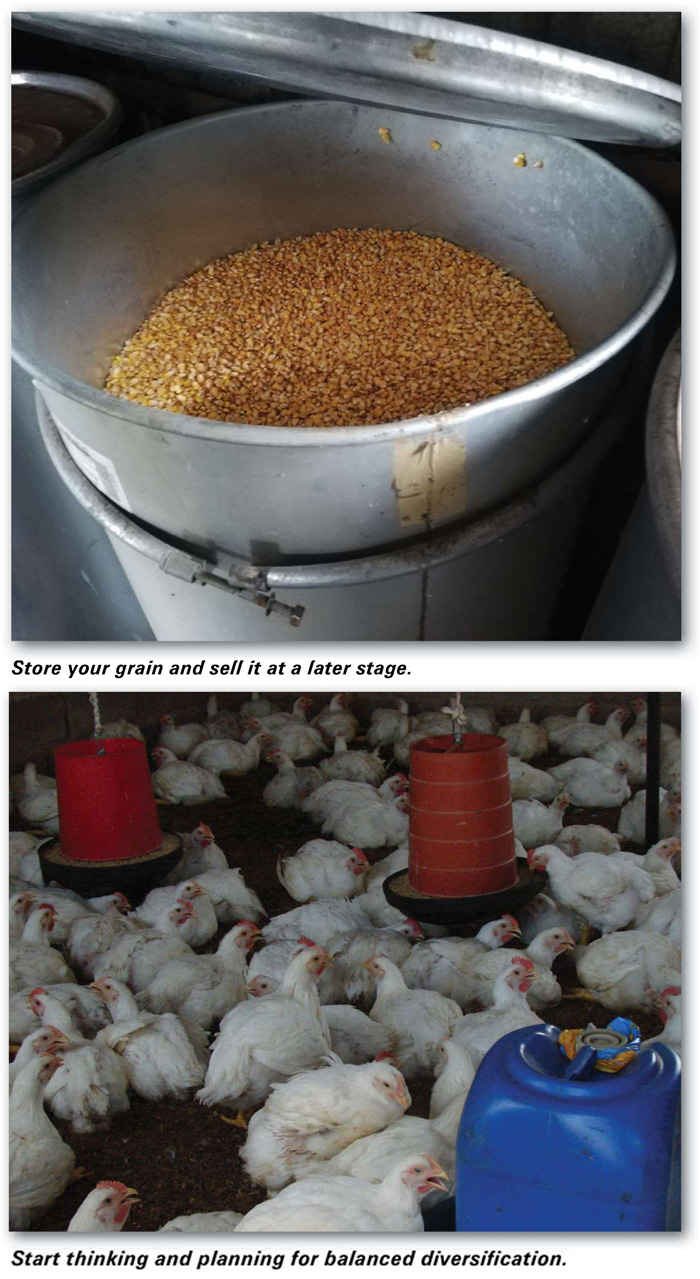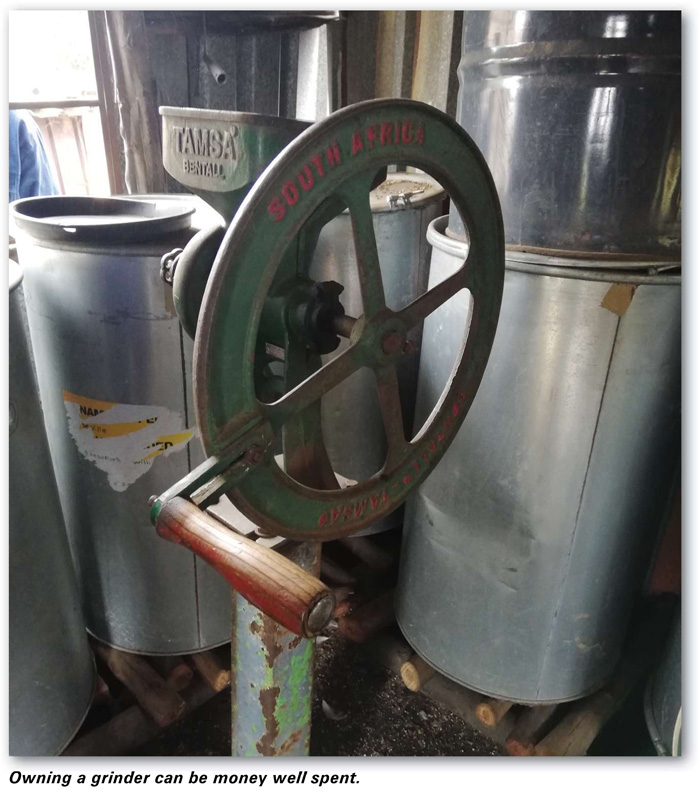July 2019
| Gavin Mathews, Bachelors in environmental management. Send an email to gavmat@gmail.com |  |
What happens to the grain you harvest after you sell it? Yes, we know that it enters the food processing chain. But have you ever thought that perhaps certain steps in this chain could be done by you on your farm?
From the point that you harvest the grain there are numerous different stages that it goes though depending on the food product it will become or form part of. The simplest and most straight forward of these being maize meal in the case of maize grain and flour in the case of wheat.
For most South Africans these products form part of our everyday diets and are vital in ensuring food security in our country. If we are producing the grain ourselves; why can’t we produce the maize meal ourselves and cut out the extra expense that the retailers add on as well as the effort of carting a big 50 kg bag back from town after our shopping trip? Let’s take the grain further, let’s take the grain from field to fork.
Looking back into the history of mankind, we can see that the art of grinding grain into food has been passed down through generations and although we have progressed from grind stone to modern mills, the concept remains the same.
 So why is it that we pass the responsibility of processing on to someone else just to buy it back? Well, it is simple; we have chosen the fulfilment of cash in hand over grain in the tank. But does this really put us in a better position? I don’t think so. I think we need to be looking at balanced diversification. How about we use some at green mealie stage for selling as well as eating and harvest the rest for own use and for sale. This sounds complicated I’m sure, but all it needs is some thorough planning.
So why is it that we pass the responsibility of processing on to someone else just to buy it back? Well, it is simple; we have chosen the fulfilment of cash in hand over grain in the tank. But does this really put us in a better position? I don’t think so. I think we need to be looking at balanced diversification. How about we use some at green mealie stage for selling as well as eating and harvest the rest for own use and for sale. This sounds complicated I’m sure, but all it needs is some thorough planning.
HOW DO I PLAN FOR BALANCED DIVERSIFICATION IN MY GRAIN HARVEST?
First and foremost, you need to think about the needs of yourself and your family. What are your financial needs as well as your food needs? Now you need to plan how your grain crop can best supplement your needs. Maize has a life cycle which allows us to consume it at two different stages; the green mealie stage and the dry grain stage. As farmer you can use this to your advantage to sell a percentage at green mealie stage, perhaps 10%. You can harvest the ripe ears of maize and sell them locally or in town at a premium price. This is direct cash in the pocket for you and your family.
How much income can green mealies bring?
This is a simple calculation. Let us say for example that you have planted one hectare of maize and you planted 40 000 plants per hectare. 10% of 40 000 plants is 4 000 plants. Let us assume that each plant has one cob per plant which means that you will have 4 000 cobs of green mealies to sell. The average market price for a green mealie is approximately R5 depending on size. This means that you can generate an income of roughly R20 000 through the sale of green mealies. Your family will also have the nutritional benefit of having green mealies to eat at the dining room table. This is fantastic; your maize is not even fully matured and you are starting to reap the benefits of planting a crop.
 If you and your family consumed another 5% over and above the 10% sold as green mealies it would mean that you have about 85% left to mature and dry for later use. The question is what will you do with the grain once harvested? If we continue planning for balanced diversification, we could decide to sell 40% as grain to bring in some quick income. The amount of money that this will bring in will depend on a number of factors including the climatic conditions of that year, how good your management was and what the maize price is. But let us assume that it has been a good year and you managed to harvest four tons of grain from the remaining 85% of your plants. If you sell 40% of four tons, it would mean that you will sell approximately 1,6 tons of dry grain. At today’s maize price this will convert into roughly R4 000 (at R2 500/ton). This is a good position to be in especially considering you still have 45% that will be stored.
If you and your family consumed another 5% over and above the 10% sold as green mealies it would mean that you have about 85% left to mature and dry for later use. The question is what will you do with the grain once harvested? If we continue planning for balanced diversification, we could decide to sell 40% as grain to bring in some quick income. The amount of money that this will bring in will depend on a number of factors including the climatic conditions of that year, how good your management was and what the maize price is. But let us assume that it has been a good year and you managed to harvest four tons of grain from the remaining 85% of your plants. If you sell 40% of four tons, it would mean that you will sell approximately 1,6 tons of dry grain. At today’s maize price this will convert into roughly R4 000 (at R2 500/ton). This is a good position to be in especially considering you still have 45% that will be stored.
What to do with your stored grain?
You could plan to store your grain and sell it a little bit at a time to spread your income over a long period of time or you could consider processing it further and adding value to your product as discussed in the introduction to this article.
HOW TO PROCESS IT FURTHER
There are many modern small-scale diesel or electric operated maize mills that are on the market these days which are providing small scale farmers with new options to take their grain further to the next stage of processing – maize meal.
The new mills can grind the maize to virtually the same standard as you would purchase from the supermarket. It also provides options to grind feed for your animals. Feeding a ration of grain into your animal’s diets in conjunction with a good dosing programme will ensure healthy animals and generate increased income for your household. Obviously it costs money to purchase such a milling machine but if one looks at it as an investment where value is added and more money can be made by selling maize meal or where money can be saved by producing maize meal for your own consumption, then it may just be an option worth considering and worth saving for. If the expense of such a machine is simply out of the question then perhaps you could consider buying it with a group of fellow farmers and share the use of it.
We need to start being clever about the way that we use our grain. Start thinking and planning for balanced diversification. Take advantage of green mealies – look at options of grinding your maize into meal and adding value to your product. Make sure that your family is fed and aim to have a supplementary income from your maize crop. By planting as little as one hectare, you can make a huge difference to the well being of your family as well as your community.
For information on small scale maize mills please feel free to contact your mentor or your nearest Grain SA office. There are a number of farmers who are already using these mills and adding value to their grain. The Grain SA Small Scale Farmer of the Year for 2018 is one such farmer, Mr Sicelo Nhlanhla Mngadi, who won one of these mills as his prize at the annual Grain SA Farmer Development Day of Celebration in Bothaville. He says that the machine is amazing and has given him so many more options to market his maize.
Publication: July 2019
Section: Pula/Imvula